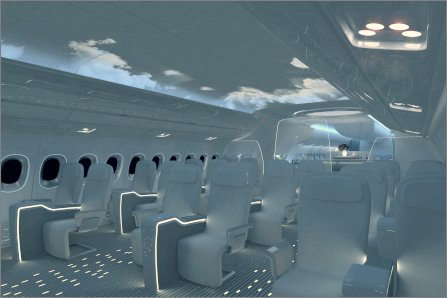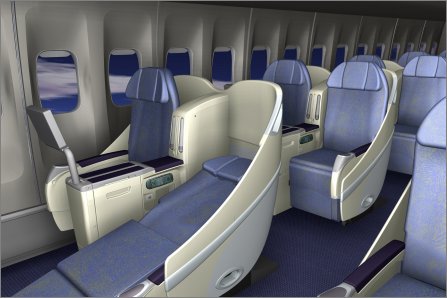Airline passengers want greater comfort, particularly on long-haul flights. Can cabin interior specialists satisfy their demands?
Given the crowded cabins typical of air travel today, the most important thing for a passenger boarding an aircraft is likely to be whether there is enough room in the seat. Once settled down, they will notice the general feel of the cabin in terms of decor, space and functionality. “Cabin interiors are the big differentiator these days,” says one airline.
At the Aircraft Interiors Expo 2006 show, in Hamburg, Germany, on 4-6 April the contest to supply airlines with the best the industry has to offer will be taken a step further with the unveiling of Airbus’s A350 cabin interior mock-up.
Market giants
Coming hot on the heels of Boeing’s display of its 787 cabin architecture at the Aircraft Interiors Expo Asia in September, the cabin interiors industry is attracting unprecedented attention.
In 2005 Airbus used the Hamburg show to reveal, for the first time in public, a full-scale mock-up of the A380’s double-decker interior. Since then, customer airlines have been finalising their own plans for how the A380 cabin will be configured – but do not expect any announcements at Hamburg. The airlines are staying extremely secretive about how they plan to use the huge amount of internal space available inside the giant.
One thing is clear – on the back of a renewed emphasis on improving the cabin environment (often driven by the trend towards ultra-long-range aircraft) the cabin interiors industry itself is going through a period of strong consolidation and development.
|
| The Airbus A380 cabin will feature "virtual sky" mood lighting |
According to Anthony James, sales and marketing director for show organiser UKIP Media & Events, Airbus and Boeing are keen to drive consolidation within the industry as they seek to simplify and streamline supplier lines, while protecting delivery timetables. “Airlines would also prefer to have a single entity to take responsibility for lifetime maintenance and service packages,” he adds. “However, we see a contrasting trend for greater customisation and product innovation, so there is still room for niche players offering quality products.”
Anyone planning to join the fray as a new entrant should think carefully, however. “This is a notoriously hard industry for an outsider to crack,” says James. “The margins are extremely tight, production runs small compared to the automotive sector and the regulations and certification requirements increasingly strict.”
A seismic industry development took place in July 2005 when France’s Zodiac acquired C&D Aerospace, one of the world leaders in aircraft cabin interiors, catapulting Zodiac to equal status with B/E Aerospace in terms of market share. Both companies are now approaching the billion-dollar annual turnover mark and are ready for further growth as the cabin interiors market strengthens and prepares for the forthcoming new generation of single-aisle aircraft.
Policy shift
Zodiac cabin interiors chief executive Maurice Pinault says the C&D move “fitted our global strategy. This acquisition makes us by far the number one in terms of size and breadth. Now we must make it work.” He points to the major shift in Boeing’s philosophy with the 787, towards purchasing complete integrated systems rather than individual components. “With the 747,” he remembers, “Boeing had dozens of engineers working with more than 200 suppliers to equip the cabin. Now, the idea is to encourage companies to offer integrated systems so that Boeing needs fewer engineers.”
Zodiac won the contract to provide the complete water and waste system for the 787, building on its success in winning the deal to supply a similar system for the A380, which was the first time a contract for an integrated system of this size had been awarded to a single supplier. “Airbus and Boeing expect suppliers these days to have a total design and manufacturing capability, including three-dimensional modelling,” says Pinault. He adds that a company like Zodiac “must offer the best in all of the components it supplies within a particular system. There must not be any weak links.”
At least in economy class, the trend today is for the aircraft manufacturers to offer an increasingly limited choice of cabin interior options to the airlines to save costs and reduce delivery times. This represents a major change from the past when, for example, Boeing gave 747 customers a choice of toilet systems from two different suppliers. Today, Airbus customers are supplied with toilets from a single supplier – Dasell – and the same is true of seats and galleys. The story is different in business- and first- class cabins, however. “This is where the true differentiation is found”, says Pinault. “We’ve seen significant growth at the higher end,” he adds. “This will continue. We do not see the airlines going back to where they were before.”
B/E Aerospace claims to be the world’s leading manufacturer of cabin interior products for commercial aircraft, a position its managing director and chief executive Michael Baughan says the company reached “through organic growth and acquisition. We have focused very strongly on the cabin interiors market and particularly on cabin retrofit, which now accounts for more than 50% of our work in the sector, depending on the business cycle.”
Baughan says there is significant cross-feed from the high-end business jet market into the new “super first class” cabins where B/E has contracts with several airlines, including the A380s ordered by Emirates and Qantas. He points to moves towards offering a more integrated, holistic cabin design throughout the aircraft.
Integrated style
“Airlines are considering more than ever the need for integrated styling in the cabin, and there is much more interest in things like lighting, which were not an issue before. We are working with developments such as digital mood lighting, which can produce artificial dawns and sunsets to mitigate jet lag.”
B/E is by far the world’s largest airliner seat manufacturer, with an installed base of more than 1 million seats in service and more manufacturing capability than all other seat manufacturers combined. Its latest success came in February when it announced the Korean Air order for its “MiniPod” lie-flat business-class seats for the airline’s A380s. “From a market perspective,” says Baughan, “things are moving at a fast clip.”
|
| B/E's "MinPod" seating for business class will be fitted in Korean Air's A380s |
UK-based Premium Aircraft Interiors gained third place in the cabin interiors league table through a careful policy of acquisitions since 1997, when it purchased Contour Seats, now Contour Premium Seats, then German companies Sell and Dasell and in 2001 US interiors specialist Heath Tecna. Together the group, with a turnover of around $450 million a year, now claims to offer a more comprehensive range of cabin interior products than any other company.
Ben Betell, Premium’s business development director, says there is a strong correlation between cabin interior upgrade business and that for new aircraft. “Airlines buying new aircraft want to bring their current fleet up to the new aircraft standard. We see this end of the business increasing, especially with the huge projected growth in air transport in the next few years.”
Scott Savian, vice-president of marketing and sales at C&D Aerospace, says the cabin interiors market is “burgeoning, particularly with the heavy emphasis on passenger experience with new aircraft including the A380 and most particularly the 787. With potential 737, A340, and A320 replacements coming through in a few years, I believe this phenomenon will become even more prevalent as the original equipment manufacturers use their interiors as true differentiators.” B/E’s Baughan agrees: “The cabin interior is the place where airlines achieve brand identity and differentiation. It is a crucial component of the airline marketing effort and there is a lot of competition out there.”
Design teams
One significant trend is the move towards using outside design houses for designing airliner interiors.
These days, Airbus and Boeing both have teams dedicated to liaising with airlines on cabin design and customisation, which advise on weight and certification issues, maintenance and installation and generally guide the airline through the entire process.
The teams are often supported by an external design agency chosen by the airline – although the larger carriers often have their own design teams, and hire industrial design companies who can offer them something different.
Lufthansa Technik, one of several large maintenance, repair and overhaul organisations that offer comprehensive cabin interior upgrades, believes the trend will continue as the need for innovative cabin interior designs to help passengers cope with ultra-long-range travel grows.
“We co-operate with several well-known design agencies,” it says. “They give us the flexibility we need without having to acquire an in-house capability, which means we can weather industry downturns more easily.” It also points to the increasing use of automotive design houses like BMW’s Designworks USA facility, which has worked on several business aircraft interiors and is now working with Airbus on the A350 cabin interior.
At the other end of the market the UK low-cost carriers are opting for ever more spartan cabin interiors in their search for new ways to cut costs. One of the main drivers in choosing seats, carpets and other high-use items is the airlines’ rapid turnarounds, which places more emphasis on wear and tear and on the need for quicker cleaning. So much so, in fact, that Ryanair now stores passenger lifejackets in the overhead bins (to make it easier to clean under the seats) and has dispensed with seat-back pockets.
However, US low-cost airline JetBlue has pioneered a cabin philosophy incorporating a high-quality interior complete with in-flight entertainment and some of the widest seats in the business (thanks to narrow aisles not needed for food trolleys) – an idea which seems to have paid off handsomely with customers. ■
JULIAN MOXON / LONDON
Source: Flight International

























